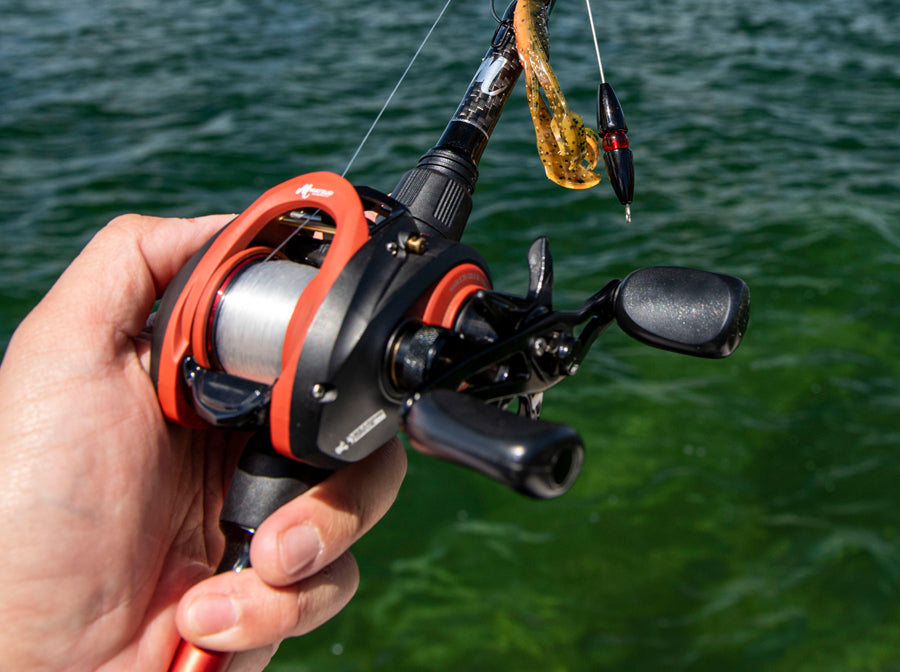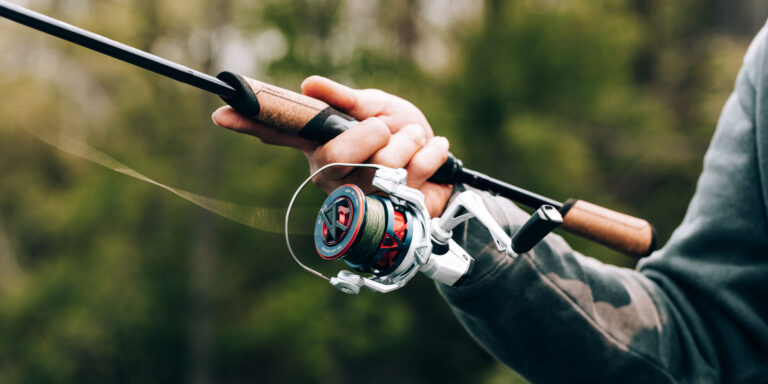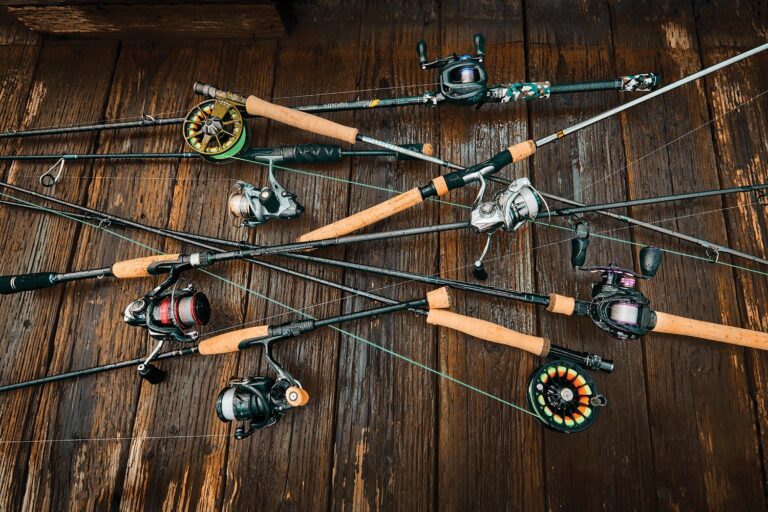To tie fishing line on a baitcasting reel, start by threading the line through the reel’s line guide and tie an overhand knot around the spool. Then, wrap the line around the spool, making sure it is tight and evenly distributed.
Finally, tie a secure knot, such as an improved clinch knot, to finish attaching the line to the reel.

Credit: www.calcuttaoutdoors.com
Understanding The Basics Of Baitcasting Reels And Fishing Lines
Baitcasting reels are a popular choice among avid anglers due to their versatility and ability to handle heavier lines and lures. However, for beginners, understanding the ins and outs of baitcasting reels can be a bit overwhelming. In this section, we will explore the basics of baitcasting reels and fishing lines, including a comparison with spinning reels, the types of fishing lines suitable for baitcasting reels, and the factors to consider when choosing fishing lines for baitcasting reels.
Comparing Baitcasting Reels To Spinning Reels
When it comes to choosing between baitcasting reels and spinning reels, it’s important to understand the unique features and advantages of each. Here are some key points to consider:
- Baitcasting reels generally offer more casting accuracy and control compared to spinning reels, making them ideal for targeting specific spots.
- Spinning reels, on the other hand, are typically easier to use and require less practice to master, making them a popular choice for beginners.
- Baitcasting reels are better suited for heavier lines and lures, making them ideal for fishing in situations where greater strength and control are needed.
- Spinning reels excel in situations that require finesse and delicate presentations, making them a go-to choice for light tackle fishing.
Types Of Fishing Lines Suitable For Baitcasting Reels
Choosing the right fishing line for your baitcasting reel is crucial to achieving optimal performance. Here are some common types of fishing lines that are suitable for baitcasting reels:
- Monofilament line: This versatile line is easy to handle and offers good strength, abrasion resistance, and flexibility. It is an excellent choice for beginners due to its forgiving nature and affordability.
- Fluorocarbon line: Known for its excellent invisibility underwater, fluorocarbon line is a popular choice for anglers targeting finicky fish. It has low stretch and high sensitivity, making it ideal for detecting even the most subtle bites.
- Braided line: Made of multiple strands of synthetic fibers, braided line is extremely strong and offers excellent abrasion resistance. It has minimal stretch, which provides greater sensitivity and enhances hook-setting power.
Factors To Consider When Choosing Fishing Lines For Baitcasting Reels
Selecting the right fishing line for your baitcasting reel involves considering various factors. Here are some crucial points to keep in mind:
- Line strength: Determine the appropriate line strength based on the type of fish you plan to target and the fishing conditions you expect to encounter. Heavier lines are suitable for larger fish species and situations where you may encounter obstacles.
- Line diameter: Thinner lines have less visibility underwater and allow for longer casts, while thicker lines offer increased strength and abrasion resistance. Consider the balance between stealth and strength based on your fishing needs.
- Casting distance: Some lines offer better casting distance due to their low friction properties, while others may not cast as far. Evaluate your casting requirements and choose a line that suits your needs.
- Line visibility: If fishing in clear water or targeting skittish fish, consider using a line with low visibility, such as fluorocarbon, to increase your chances of success.
By understanding the basics of baitcasting reels and fishing lines, you can make informed decisions when it comes to selecting the most suitable line for your baitcasting reel. Remember to consider the specific advantages of baitcasting reels compared to spinning reels and weigh the different types of fishing lines available based on their characteristics and the fishing conditions you expect to encounter.
Happy angling!
Step-By-Step Guide To Tying Fishing Line On A Baitcasting Reel
Fishing enthusiasts know that tying a fishing line on a baitcasting reel is an essential skill to master. Whether you’re a beginner or an experienced angler, knowing how to properly secure your line is crucial for a successful day on the water.
In this step-by-step guide, we’ll walk you through the process of tying fishing line on a baitcasting reel, ensuring that your line is securely attached and ready to tackle any fish that comes your way.
Preparing The Reel And Line For The Tying Process
Before we dive into the actual tying process, there are a few steps you should take to ensure that your reel and line are ready for the task at hand. Here’s what you need to do:
- Ensure that your reel is clean and free from any dirt, debris, or old fishing line.
- Inspect your fishing line for any signs of wear or damage. If you notice any weak spots or frays, it’s best to replace the line before proceeding.
- Set up your baitcasting reel on a stable surface to make the tying process easier and more efficient.
Choosing The Right Knot For Baitcasting Reels
When it comes to tying fishing line on a baitcasting reel, there are various knots you can use. However, one of the most popular and effective knots for this purpose is the arbor knot. This knot ensures a secure connection between the line and the spool, minimizing the chances of slippage.
Here’s how you can tie an arbor knot:
Step 1: Creating An Overhand Knot To Form A Loop
- Start by creating an overhand knot at the end of your fishing line. Leave a small tag end to make the subsequent steps easier.
Step 2: Passing The Line Through The Reel’S Line Guide
- Take the loop created by the overhand knot and pass it through the line guide located on your baitcasting reel. Ensure that the loop is large enough to easily pass through.
Step 3: Wrapping The Line Around The Spool
- With the loop now through the line guide, wrap the fishing line around the spool of your baitcasting reel. Make approximately five to six wraps tightly, ensuring that each wrap is snugly placed next to the previous one.
Step 4: Securing The Line With An Arbor Knot
- Take the tag end of your fishing line and pass it through the loop created by the overhand knot. Gently pull the tag end to tighten the knot, ensuring that it is firmly secured around the spool.
Step 5: Tightening And Testing The Knot
- Before trimming any excess line, make sure the arbor knot is tightened properly by giving it a gentle tug. This step is crucial to ensure the knot’s strength and reliability. Once you’re confident that the knot is secure, test it further by pulling on the mainline to ensure it holds up under tension.
Step 6: Trimming Excess Line For Optimal Performance
- After confirming the strength of the knot, it’s time to trim any excess line using a pair of scissors or line cutters. Leave a small tag end of about 1/8 inch to avoid the knot unraveling.
By following these simple steps, you can easily tie a fishing line on a baitcasting reel, setting yourself up for a successful and enjoyable fishing experience. Remember to take your time and ensure that each step is executed properly to avoid any line slippage or knot failure.
Happy fishing!
Tips And Tricks For Tying Fishing Line Like A Pro
Tying fishing line on a baitcasting reel may seem daunting for beginners, but with the right techniques and a little practice, you can become an expert in no time. In this section, we’ll explore various tips and tricks that will help you tie fishing line like a pro.
Whether you’re a seasoned angler or just starting out, these strategies will enhance your knot strength, improve your casting, and prevent common mistakes.
Using Lubricants To Enhance Knot Strength
- Lubricants such as saliva, water, or specific knot lubricants can greatly enhance the strength and durability of your knots.
- Applying a small amount of lubricant to the knot before tightening it reduces friction and ensures a secure knot.
- Lubricants also prevent the fishing line from overheating during the knot-tying process, which can weaken the line.
Testing Knot Strength Before Heading Out
- Before hitting the water, it’s essential to test the strength of your knots.
- Give each knot a firm tug to ensure it holds securely.
- If a knot slips or fails, re-tie it using the appropriate technique.
- Testing knot strength before fishing gives you confidence and helps avoid lost catches.
Adjusting Tension And Line Placement For Smooth Casting
- Proper tension adjustment on a baitcasting reel is crucial for smooth casting.
- Adjust the brake system and spool tension knob to find the right balance for your lure and fishing conditions.
- Ensure the fishing line is properly placed on the spool to prevent backlash and line twists.
- A well-adjusted reel and correctly positioned line reduce casting issues and improve the overall fishing experience.
Avoiding Common Mistakes When Tying Fishing Line
- One common mistake anglers make is using a wrong or incompatible knot for the fishing line type.
- Always select a knot suitable for the line’s material and thickness.
- Another mistake to avoid is rushing the knot-tying process. Take your time to ensure the knot is correctly tied and secure.
- Over- or under-tightening knots can weaken them and increase the chances of line breakage.
Practicing Knot Tying To Improve Speed And Efficiency
- Knot tying is a skill that improves with practice.
- To become faster and more efficient at tying knots, dedicate some time to practice different knots and techniques.
- Use spare fishing line or rope to simulate actual fishing conditions.
- Familiarize yourself with various knots and choose those that best suit your fishing needs.
Mastering the art of tying fishing line on a baitcasting reel takes practice, but by following these tips and tricks, you’ll be able to achieve secure and reliable knots. Remember to use lubricants to enhance knot strength, test knots for durability, adjust tension and line placement for smooth casting, avoid common mistakes, and practice regularly to improve speed and efficiency.
With these strategies, you’ll be ready to tackle any fishing adventure with confidence.
Conclusion
Tying fishing line on a baitcasting reel may seem intimidating at first, but with the right technique and practice, it becomes second nature. Remember to choose the right knot for the job, such as the improved clinch knot or the palomar knot, and follow a step-by-step process for a secure connection.
Take your time and pay attention to details like tension and wrapping the line correctly. A proper knot will ensure that your line stays connected to the reel, preventing frustrating and costly line breaks while fishing. Additionally, maintaining a clean and well-maintained reel will extend its lifespan and performance.
With these tips in mind, you’ll be able to confidently tie fishing line on a baitcasting reel and enjoy a successful and enjoyable day on the water. So, grab your gear, head out to your favorite fishing spot, and let the line tying adventure begin!





